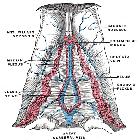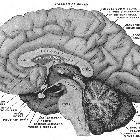internal cerebral veins
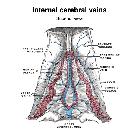


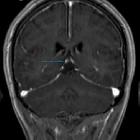
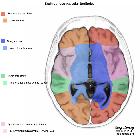
The deep cerebral veins drain the deep white matter and grey matter that surround the basal cisterns and ventricular system. The deep veins are responsible for the outflow of approximately the inner 80% of the hemisphere. They provide useful landmarks for skull base and intraventricular surgery and are involved in multiple congenital and acquired pathologies. Like most venous systems, they are prone to significant anatomical variance that is beyond the scope of this summary article.
Overview
The deep cerebral venous system centers on the great cerebral vein (of Galen), which joins with the inferior sagittal sinus to drain into the straight sinus at the base of the falx cerebri. The vein of Galen itself is formed by the confluence of a number of paired veins: internal cerebral veins, the Basal veins of Rosenthal, the anterior calcarine veins and superior vermian veins.
This article presents a very brief overview of these major veins, that are discussed in more detail in separate articles.
Internal cerebral vein
The internal cerebral veins are formed at the foramina of Monro by the convergence of the septal vein (of the septum pellucidum) and the thalamostriate vein (of the thalamostriate groove), with some authors also noting the addition of the anterior choroidal veins.
The internal cerebral veins lie in the velum interpositum, between the layers of tela in the roof of the third ventricle, alongside the median posterior choroidal arteries. They may be separated and passed between in a transforniceal or transchoroidal approach to the 3rd ventricle. Posteriorly, they enter the quadrigeminal cistern and soon join the great cerebral vein.
Read more: internal cerebral veins
Basal vein of Rosenthal
The basal vein is highly complex (Rhoton suggests over 14 named veins drain into it) and an in-depth discussion of its anatomy is beyond the scope of this article. More simply, the basal vein is formed near the limen insulae by the juncture of the deep middle cerebral vein and the anterior cerebral vein. As it courses through the perimesencephalic cisterns it receives several veins. Anteriorly it receives the peduncular, insular, orbitofrontal, olfactory, uncal, and inferior striate veins. While posterior to the anterior choroidal point it receives the inferior ventricular vein, anterior longitudinal hippocampal vein, anterior hippocampal vein, lateral mesencephalic vein, and temporal cortical veins. More simply, it receives the veins of the insula, mesial temporal lobe and some parts of the mesencephalon. Distally, it drains into the great cerebral vein.
Read more: basal vein
Great cerebral vein of Galen
The great cerebral vein of Galen, as already described, is formed by the confluence of the paired internal cerebral veins, the basal veins, the medial occipital (anterior calcarine) veins, and the superior vermian veins. The great cerebral vein passes inferior to the splenium of the callosum to enter the straight sinus, with the inferior sagittal sinus, at the juncture of the falx cerebri and tentorium cerebelli. The angle of acuity of the veins entry into the straight sinus is dependent on the relationship between the splenium and tentorial apex.
Read more: vein of galen
Siehe auch:
- dritter Ventrikel
- velum interpositum
- Sinus rectus
- Vena cerebri magna
- Sinus sagittalis inferior
- basal veins of Rosenthal
- superior thalamostriate vein
- vein of the septum pellucidum
und weiter:

 Assoziationen und Differentialdiagnosen zu internal cerebral veins:
Assoziationen und Differentialdiagnosen zu internal cerebral veins:

